Themed collection Electrochemical processes at the nanoscale: from fundamentals to applications

Electrochemistry at the Nanoscale
This special issue of Nanoscale presents the latest advances in the field of nanoelectrochemistry by leading experts across different disciplines and provides in-depth discussions.

Nanoscale, 2016,8, 13825-13827
https://doi.org/10.1039/C6NR90142E
Nanoscale electrodeposition of low-dimensional metal phases and clusters
STM-tip induced electrodeposition of metal nanoclusters can be applied not only in systems with liquid electrolytes but also in thin film solid state electrochemical systems.
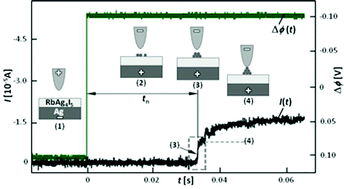
Nanoscale, 2016,8, 13880-13892
https://doi.org/10.1039/C6NR01547F
Nanoionic devices enabling a multitude of new features
In recent years, interesting nanoscale phenomena caused by physical or chemical effects due to local ion transfers near heterointerfaces using ionic conductors have been discovered, and the so-called “nanoionic devices” (which apply new functionalities gained by exploiting those phenomena) are being proposed.
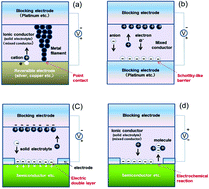
Nanoscale, 2016,8, 13873-13879
https://doi.org/10.1039/C6NR00956E
Electrochemical phase formation: classical and atomistic theoretical models
The process of electrochemical phase formation at constant thermodynamic supersaturation is considered in terms of classical and atomistic nucleation theories.
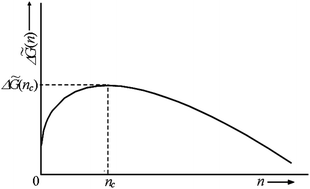
Nanoscale, 2016,8, 13867-13872
https://doi.org/10.1039/C6NR02354A
The Atomic scale structure of liquid metal–electrolyte interfaces
Electrochemical interfaces between immiscible liquids have lately received renewed interest, both for gaining fundamental insight as well as for applications in nanomaterial synthesis.
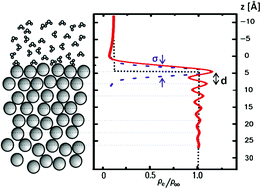
Nanoscale, 2016,8, 13859-13866
https://doi.org/10.1039/C6NR01571A
Solid-state electrochemistry on the nanometer and atomic scales: the scanning probe microscopy approach
This brief review provides an overview of existing advanced scanning probe microscopy techniques used to probe nanoscale electrochemistry in solid state materials.

Nanoscale, 2016,8, 13838-13858
https://doi.org/10.1039/C6NR01524G
Nanoscale electrochemistry using dielectric thin films as solid electrolytes
Materials with dielectric properties at the macroscopic level can behave as solid electrolytes at the nanoscale, opening new perspectives for fundamental understanding and applications.
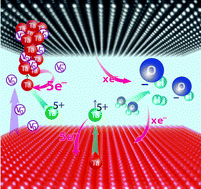
Nanoscale, 2016,8, 13828-13837
https://doi.org/10.1039/C6NR01383J
A novel Pt–Co alloy hydrogen anode catalyst with superlative activity, CO-tolerance and robustness
PtCo nanoparticles, having two atomic layers of stabilized Pt skin, supported on carbon black (Pt2AL–PtCo/C) exhibited superlative mass activity for the CO-tolerant hydrogen oxidation reaction (HOR), together with high robustness with respect to air exposure, as a novel anode catalyst in reformate gas-based polymer electrolyte fuel cells.
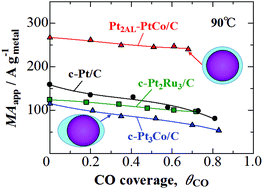
Nanoscale, 2016,8, 13893-13897
https://doi.org/10.1039/C6NR00778C
On the chemical stability of post-lithiated garnet Al-stabilized Li7La3Zr2O12 solid state electrolyte thin films
For tuning the electrical conductivity and effective use of these structures in future batteries, understanding this material system is of great importance as the chemical stability of the cubic Li7La3Zr2O12 phase in the thin film system will control its effective use.
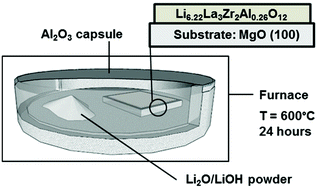
Nanoscale, 2016,8, 14746-14753
https://doi.org/10.1039/C6NR04162K
Microstructural transitions in resistive random access memory composed of molybdenum oxide with copper during switching cycles
Two set and two reset modes of CBRAM were investigated using in situ TEM.
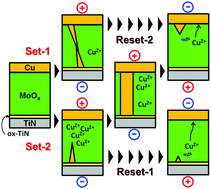
Nanoscale, 2016,8, 14754-14766
https://doi.org/10.1039/C6NR02602H
Ag2S atomic switch-based ‘tug of war’ for decision making
A nano decision maker for future computer architecture, the first implementation of the theoretical ‘tug of war’ computing model in an electronic device.
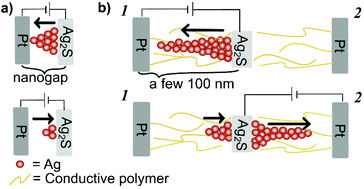
Nanoscale, 2016,8, 14031-14036
https://doi.org/10.1039/C6NR00690F
In situ and operando atomic force microscopy of high-capacity nano-silicon based electrodes for lithium-ion batteries
AFM is a powerful tool suitable for in situ and operando studies of structural changes and solid-electrolyte interphase formation in practical battery electrodes containing polymer binder and carbon additive.

Nanoscale, 2016,8, 14048-14056
https://doi.org/10.1039/C6NR03575B
Atomistic simulations of electrochemical metallization cells: mechanisms of ultra-fast resistance switching in nanoscale devices
We describe a new method that enables reactive molecular dynamics (MD) simulations of electrochemical processes and apply it to study electrochemical metallization cells and the effect of device geometry on switching timescales.
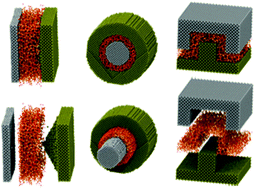
Nanoscale, 2016,8, 14037-14047
https://doi.org/10.1039/C6NR01335J
Electrochemical metallization switching with a platinum group metal in different oxides
Resistive switching due to Pd migration in a Pd/SiOx:Pd/Pd planar junction. Bright Pd protrusions were derived from the anode during SET and small voids were formed between filaments. The void regions were enlarged and Pd filaments retreated after RESET.
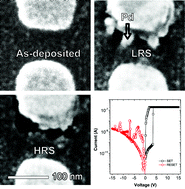
Nanoscale, 2016,8, 14023-14030
https://doi.org/10.1039/C6NR01085G
Engineering incremental resistive switching in TaOx based memristors for brain-inspired computing
The introduction of a nanoscale diffusion limiting layer (DLL) into tantalum oxide based memristors leads to improved analog resistive switching.
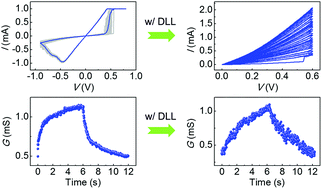
Nanoscale, 2016,8, 14015-14022
https://doi.org/10.1039/C6NR00476H
In situ scanning tunneling microscopy studies of the SEI formation on graphite electrodes for Li+-ion batteries
The SEI-formation on graphitic electrodes operated as an Li+-ion battery anode in a standard 1 M LiPF6 EC/DMC (1 : 1) electrolyte has been studied in situ by EC-STM.

Nanoscale, 2016,8, 14004-14014
https://doi.org/10.1039/C6NR00825A
Impedance spectra of Fe-doped SrTiO3 thin films upon bias voltage: inductive loops as a trace of ion motion
Investigation of slightly Fe-doped SrTiO3 thin films by means of impedance spectroscopy under bias voltage revealed an uncommon low frequency “inductive loop” which can be understood in terms of bias induced ion motion.
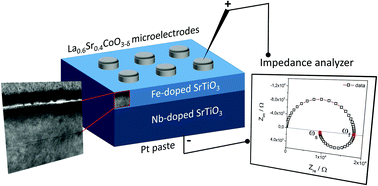
Nanoscale, 2016,8, 13954-13966
https://doi.org/10.1039/C6NR00814C
Electrochemical de-alloying in two dimensions: role of the local atomic environment
We investigate by in situ scanning tunnelling microscopy (STM) the potential dependence of the electrochemical dealloying of NiPd monoatomic layers electrodeposited on Au(111).
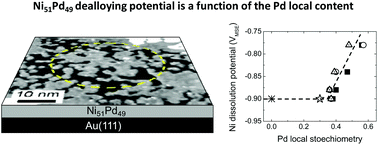
Nanoscale, 2016,8, 13985-13996
https://doi.org/10.1039/C6NR01390B
Dysprosium electrodeposition from a hexaalkylguanidinium-based ionic liquid
Electrodeposition of dysprosium layers from a tailored guanidinium based ionic liquid was characterized and optimized for magnetic applications.

Nanoscale, 2016,8, 13997-14003
https://doi.org/10.1039/C6NR01351A
Kinetic factors determining conducting filament formation in solid polymer electrolyte based planar devices
Resistive switching and conducting filament formation in solid polymer electrolyte based planar-type atomic switches have been investigated by means of current-voltage measurements and scanning electron microscopy observations.
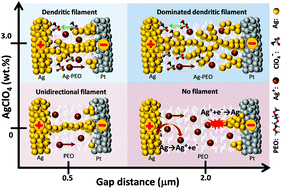
Nanoscale, 2016,8, 13976-13984
https://doi.org/10.1039/C6NR00569A
Verification of redox-processes as switching and retention failure mechanisms in Nb:SrTiO3/metal devices
We demonstrate that nanoscale redox reactions rather than purely electronic effects are responsible for resistive switching in Pt/Nb:SrTiO3 junctions.
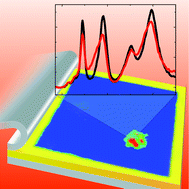
Nanoscale, 2016,8, 13967-13975
https://doi.org/10.1039/C6NR00824K
Temperature-induced transformation of electrochemically formed hydrous RuO2 layers over Ru(0001) model electrodes
Temperature induced transformation of hydrous RuO2 layers on Ru(0001) leads mostly to flat metallic Ru islands and to (100) and (111) oriented RuO2 nano particles.
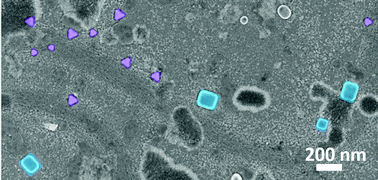
Nanoscale, 2016,8, 13944-13953
https://doi.org/10.1039/C6NR00732E
Speciation of nanoscale objects by nanoparticle imprinted matrices
Self-assembly of polymer-template nanoparticle composites followed electrooxidation of the nanoparticles yielded nanoparticle imprinted matrices that recognized selectively nanoparticles with the same size and the same ligand shell as the template nanoparticles.
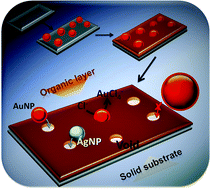
Nanoscale, 2016,8, 13934-13943
https://doi.org/10.1039/C6NR01106C
Nanoscopic structural rearrangements of the Cu-filament in conductive-bridge memories
The electrochemical reactions triggering resistive switching in conductive-bridge resistive random access memory (CBRAM) are spatially confined in few tens of nm3. In this work, a combination of two- and three-dimensional scanning probe microscopy techniques are used to study the conductive filament formation, rupture and its nanoscopic structural rearrangements.
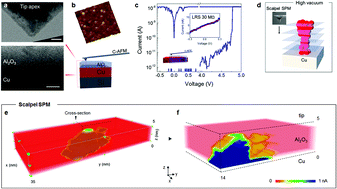
Nanoscale, 2016,8, 13915-13923
https://doi.org/10.1039/C5NR08735J
Tuning the surface electronic structure of a Pt3Ti(111) electro catalyst
Combining voltage dependent STM imaging with ab initio DFT calculations to identify the exact termination of an electro catalyst.
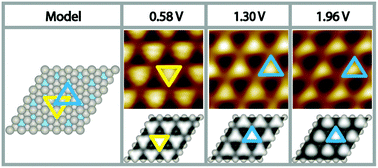
Nanoscale, 2016,8, 13924-13933
https://doi.org/10.1039/C5NR08420B
Nanoelectrode array formation by electrolytic nanoparticle impacts
Fabrication of nanoelectrode arrays from the electrolysis of impacting AgBr nanoparticles from suspension in aqueous solution.
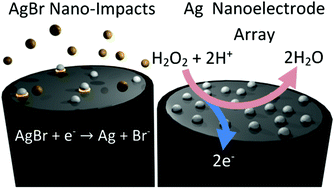
Nanoscale, 2016,8, 13908-13914
https://doi.org/10.1039/C5NR08872K
Two-step polarization switching mediated by a nonpolar intermediate phase in Hf0.4Zr0.6O2 thin films
The broken ferroelectric hysteresis loop achieved from a Hf0.4Zr0.6O2 film was interpreted based on the first order phase transition theory.
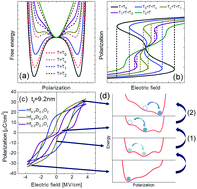
Nanoscale, 2016,8, 13898-13907
https://doi.org/10.1039/C5NR08346J
About this collection
This themed issue focuses on the role of interfaces in nanoscale electrochemical systems, new approaches and materials, how these can be facilitated through modern nanotechnology advances, and aims to showcase the physics and electrochemical properties of alternative materials and interface modifications.